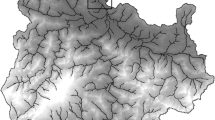Abstract
The impact of canals and their dredged-material levees on Louisiana coastal marshes has been assessed in a number of studies. The aerial coverage by canals and associated dredged-material levees has been shown to be approximately 10% of total marsh area in coastal Louisiana, which is about the same coverage as natural channels. In addition to the direct loss of marsh habitat caused by the canals, the indirect effects of dredge material placement in levees has been associated with marsh deterioration. The restoration of productive fisheries habitat by infilling pipeline canals depends upon maximizing the area of shallow water in the canals and restoring as much of the adjacent marsh habitat as possible by removing dredged-material levees. The degree to which the canal can be infilled depends upon the amount of dredged material available and the bathymetry of the canal at the time of backfilling. Geomorphic survey and analysis was used to evaluate the potential result of infilling canals and the type of habitat that may result. Comparison of data for saline and brackish canal segments indicates that for both plugged and unplugged canals, canals in brackish areas have greater potential for infilling than those in saline areas. However, older brackish canals have a greater potential for the creation of shallow water habitat than younger canals, suggesting that changes in canal cross-section may be of greater magnitude than changes in levee material. Our analysis demonstrates that simple survey techniques can be used to indicate the potential efficacy of canal infilling. We recommend that such surveys be used to evaluate both pipeline and abandoned location canals across the Louisiana coastal zone to determine the potential for increased shallow water habitat.
Similar content being viewed by others
Literature Cited
Abernethy, R. and J. G. Gosselink. 1988. Environmental conditions of a backfilled pipeline canal four years after construction. Wetlands 8:109–121.
Cahoon, D.R., D.J. Reed, J.W. Day, R.M. Boumans, J.C. Lynch, D. McNally, and N. Latif. The influence of Hurricane Andrew on sediment distribution in Louisiana coastal marshes. Journal of Coastal Research (in press).
Chabreck, R.H. and G. Linscombe. 1978. Vegetative-type map of the Louisiana coastal marshes. Louisiana Department of Wildlife and Fisheries, New Orleans, LA, USA.
Hatton, R.S., R.D. DeLaune, and W.H. Patrick. 1983. Sedimentation, accretion and subsidence in marshes of Barataria Basin, Louisiana. Limnology and Oceanography 28:494–502.
Johnson, W.B. and J.G. Gosselink. 1982. Wetland loss directly associated with canal dredging in the Louisiana coastal zone. p. 60–72.In D.F. Boesch (ed.) Proceedings of a Conference on Coastal Erosion and Wetland Modification in Louisiana. U.S. Fish and Wildlife Service Biological Services Program, Washington, DC, USA. FWS/OBS-82-59.
Linstedt, D.M., L.L. Nunn, J.C. Holmes, and E.E. Willis. 1991. History of oil and gas development in coastal Louisiana. Louisiana Geological Survey, Baton Rouge, LA, USA. Resource Information Series No. 7.
Neill, C. and R.E. Turner. 1987. Backfilling canals to mitigate wetland dredging in Louisiana coastal marshes. Environmental Management 11:823–836.
Nyman, J.A., R.D. DeLaune, and W.H. Patrick. 1990. Wetland soil formation in the rapidly subsiding Mississippi River deltaic plain: mineral and organic matter relationships. Estuarine, Coastal and Shelf Science 31:57–69.
Penland, S., R. Boyd, and J. Suter. 1988. Transgressive depositional systems of the Mississippi delta plain: a model for barrier shoreline and shelf sand development. Journal of Sedimentary Petrology 58:932–949.
Penwell 1986. Pipelines of Louisiana. Penwell Publishing Co., Tulsa, OK, USA
Rozas, L.P. 1992. Comparison of nekton habitats associated with pipeline canals and natural channels in Louisiana salt marshes. Wetlands 12:136–146.
Rozas, L.P. and D.J. Reed 1994. Comparing nekton assemblages of subtidal habitats in pipeline canals traversing brackish and saline marshes in coastal Louisiana. Wetlands 14:262–275.
Ruiz, G.M., A.H. Hines, and M.H. Posey. 1993. Shallow water as a refuge habitat for fish and crustaceans in non-vegetated estuaries: an example from Chesapeake Bay. Marine Ecology-Progress Series 99:1–16.
Scaife, W.W., R.E. Turner, and R. Costanza. 1983. Coastal Louisiana: recent land loss and canal impacts. Environmental Management 7:433–442.
Suhayda, J.N. 1988. Subsidence and sea level. p. 187–202.In R.E. Turner and D.R. Cahoon (eds.) Causes of wetland loss in the coastal central Gulf of Mexico, Vol. II: Technical Narrative. Final report submitted to Minerals Management Service, New Orleans, LA, USA. Contract No. 14-12-0001-30252. OCS Study/MMS 87-0119.
Swenson, E. M. and R. E. Turner. 1987. Spoll banks: Effects on a coastal marsh water-level regime. Estuarine Coastal Shelf Science 24:599–609.
Tabberer, D. K., W. Hagg, M. Coquat, and C. L. Cordes. 1985. Pipeline impacts on wetlands. Final environmental assessment. Minerals Management Service, New Orleans, LA, USA OCS EIS/EA MMS 85-0092.
Turner, R. E. 1987. Relationship between canal and levee density and coastal land loss in Louisiana. U.S. Fish and Wildlife Service National Wetlands Research Center, Slidell, LA, USA. Biological Report 85(14).
Turner, R.E. and D.R. Cahoon. 1988. Causes of wetland loss in the coastal central Gulf of Mexico, Vol. I: Executive Summary. Final report submitted to Minerals Management Service, New Orleans, LA, USA. Contract No. 14-12-0001-30252. OCS Study/MMS 87-0119.
Turner, R.E., R. Costanza, and W. Scaife. 1982. Canals and wetland erosion rates in coastal Louisiana. p. 73–84.In D.F. Boesch (ed.) Proceedings of a Conference on Coastal Erosion and Wetland Modification in Louisiana. U.S. Fish and Wildlife Service Biological Services Program. Washington, DC, USA. FWS/OBS-82-59.
Wicker, K. M., R. E. Emmer, D. Roberts, and J. van Beek. 1989. Pipelines, navigation channels, and facilities in sensitive coastal habitats, an analysis of outer continental shelf impacts, coastal Gulf of Mexico. Vol. I: technical narrative. U.S. Department of Interior, Minerals Management Service, Gulf of Mexico OCS Regional Office. New Orleans, LA, USA. OCS Report/MMS 89-0051.
Author information
Authors and Affiliations
Rights and permissions
About this article
Cite this article
Reed, D.J., Rozas, L.P. An evaluation of the potential for infilling existing pipeline canals in Louisiana coastal marshes. Wetlands 15, 149–158 (1995). https://doi.org/10.1007/BF03160668
Received:
Revised:
Issue Date:
DOI: https://doi.org/10.1007/BF03160668




